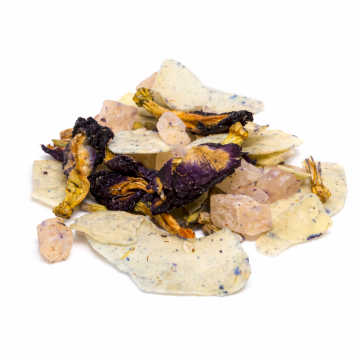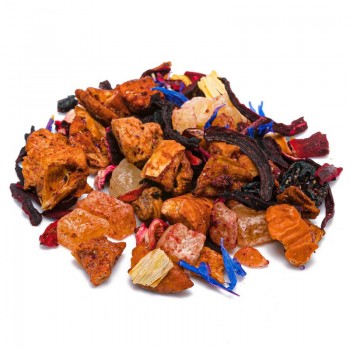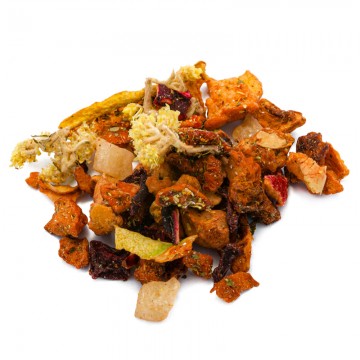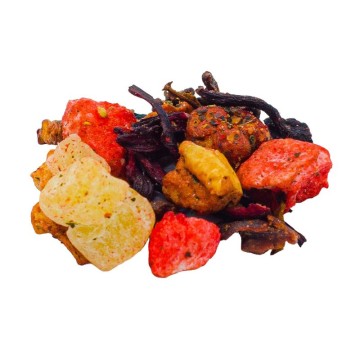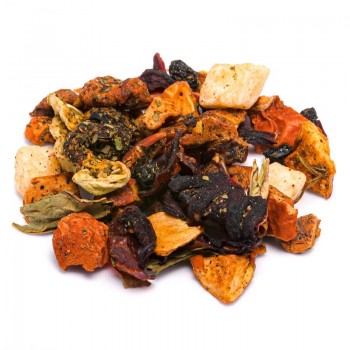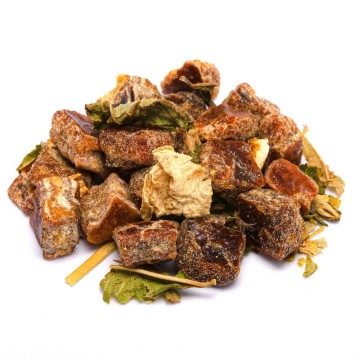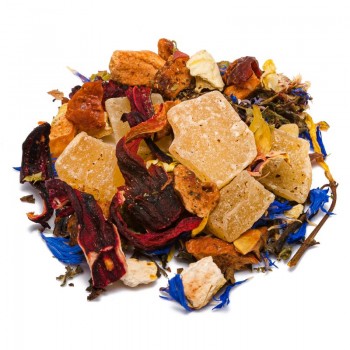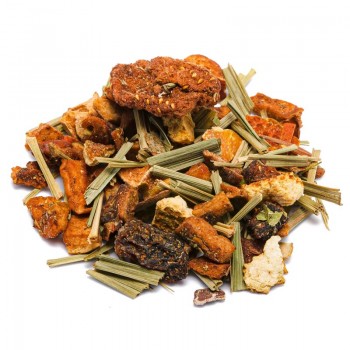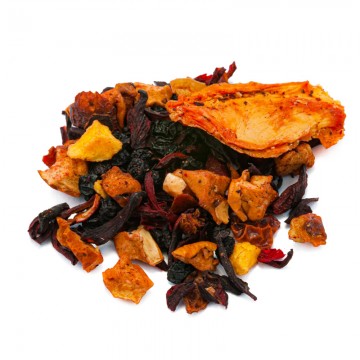The blend of ingredients from conventional cultivation and natural flavors gives an intense and aromatic touch. The taste is complex, with a rich sensation on the palate given by dates and rice flour, to which pistachios and an exquisite note of cinnamon are added. The consistency and nuances of fruit make it an ideal infusion for breakfast, and for any time of day when you want a full-bodied drink. The soft petals of hibiscus and marigold create the delicate final flavor; perfect as a relaxing infusion if drunk hot or refreshing if prepared fresh.
Apple and pistachio infusion: properties and benefits
By taking this infusion you take in the qualities of the different ingredients, first of all the apple. Known for its digestive properties, the apple provides health benefits including antioxidants and vitamins. This warm and relaxing drink provides the virtues useful against constipation, drunk in the morning it improves digestion and food transit, alleviating irritation of the intestine. The apple and pistachio infusion offers high quantities of magnesium, potassium, calcium, iron, vitamins C and A - together with hibiscus and dates. All elements that can help the body and the immune defenses. Dates and pistachios are energetic elements of the fruit infusion, which provide minerals. The hot apple and pistachio infusion also promotes the well-being of the throat and makes a useful action against irritation pleasant, thanks to the warm taste of cinnamon.
Origins and History of Cultivation
The pistachio is a food, counted among dried fruit, which has been consumed by man for thousands of years. There is evidence of pistachio in the diet of about 8,000 years ago. The legend of the Hanging Gardens of Babylon also speaks of pistachio trees (700 BC), just as pistachios are also mentioned in the Old Testament. It is thought that the pistachio is a plant native to the territory of Persia and Turkey, soon spread in the basin. The name derives from the Greek Pistàkion. Over the centuries they were highly appreciated as a precious and refined food, often considered a luxury in classical Rome. Pistachios reached Italy from Syria and then spread throughout the Mediterranean. They were easy to transport along the Silk Road, due to their durability over time. Used both as ground for sauces and to create desserts, they were appreciated for their exceptional nutritional value: they are seeds rich in proteins, fats and fibers. In Italy, large cultivations in Sicily make them a widely used element in cooking. The apple species, Malus, are native to the temperate zones of both hemispheres - northern and southern. It is believed that the apple cultivated today was domesticated from a wild apple plant, M. sieversii, about 4,000-10,000 years ago. In any case, the origin would be in the Tien Shan mountains in Central Asia. From there it spread to Western Europe along the Silk Road and hybridized with other species. Over the centuries, different selections have been made, of which the best known were born about 2,000 years ago. Today there are hundreds of varieties in Europe, then also exported to North America.
Fruit and flowers
The components of the infusion are many, and the mix includes fruits and flowers of different origins. The pistachio comes from the Pistacia vera plant, a small tree of the Anacardiaceae family. The edible part is the seeds. To grow better, the plant prefers dry soil, in warm or temperate climates. It shows very extensive branches but rarely exceeds 9 meters in height. It has broad leaves and male and female flowers (it is generally a dioecious plant). The white drupes grow in clusters about 2 cm long. When they ripen, they tend to split without releasing the seed. Under the shell, the nut has a greenish stone enclosed in a thin reddish adherent peel. The edible ones are the kernels, shelled and peeled. The apple plant is Malus domestica, which belongs to the Rosaceae family. It is a tree native to Asia, now widespread throughout the planet. The fruits differ in color and in many varieties, from yellow and green apples to red ones, with different shades. Apple trees are generally small trees, but if the tree is not pruned, it often reaches a height of 9 meters and an equally large crown. The hibiscus comes from the plant Hibiscus sabdariffa, also called rosella. It is part of the Malvaceae family. Probably native to West Africa, it is known for the edible outer part of its flower (calyx). It grows best in clay soils andin tropical climates, with average rainfall of about 25 cm per month, throughout the growing season. The date palm, (Phoenix dactylifera), is a tree of the palm family (Arecaceae). It is a plant about 23 meters tall, with a crown of leaves about 5 meters long. The date is a fruit with a single seed, or drupe, usually oblong. It can vary greatly in size, color, quality and consistency of the pulp, depending on the variety. Ceylon cinnamon (Cinnamomum verum) is an evergreen shrubby tree of the laurel family (Lauraceae), which yields the spice from its bark. Native to Sri Lanka (formerly Ceylon), the nearby Indian Malabar Coast and Myanmar (Burma) and is now also cultivated in South America and the West Indies. Related species are also cultivated as a source of cinnamon, including Chinese cassia (Cinnamomum cassia), Vietnamese cinnamon (C. loureiroi), Indonesian cinnamon (C. burmannii) and Malabar cinnamon (C. citriodorum). Calendula officinalis is an annual herbaceous plant, of the genus Calendula of the Asteraceae family. It grows in the temperate regions of Eurasia and North Africa, displays ray-shaped flowers, similar to yellow-orange petals. They are known for their beneficial and soothing cosmetic properties.
Nutritional values of apple and pistachio infusion
The main active ingredients are mineral salts, potassium, magnesium and iron, and vitamins A and C.
How to prepare the infusion?
The infusion is obtained by placing in a cup (250 ml), about 3-5 grams of the apple and pistachio mixture with water at 100 °C. Leave to infuse for 10 to 12 minutes, before drinking. Add honey or sugar, if desired.
Apple and pistachio infusion: side effects and contraindications
To get the best benefits from the mixture, it is necessary not to overdo the consumption or take the apple and pistachio infusion for too long. Excessive intake can cause intestinal gas, bloating, abdominal pain and diarrhea. Pistachios can cause allergic reactions in some people allergic to peanuts. In addition, it is advisable to evaluate all the ingredients of the infusion, to avoid allergy symptoms. Caution is advised for pregnant or breastfeeding women.

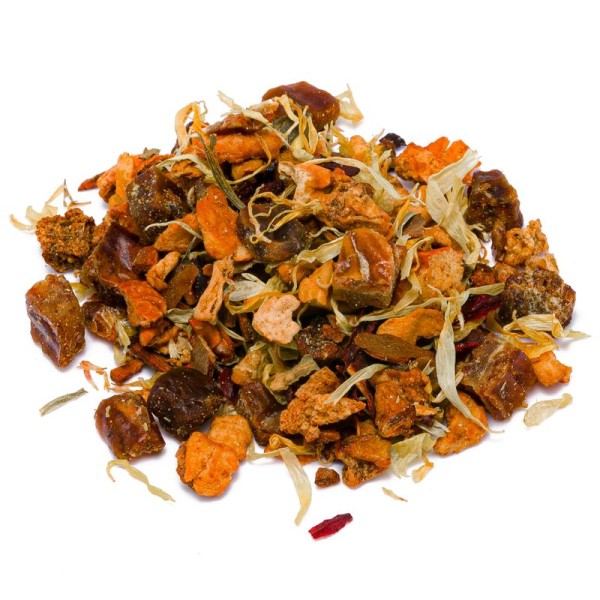









 No reward points for this product.
No reward points for this product.
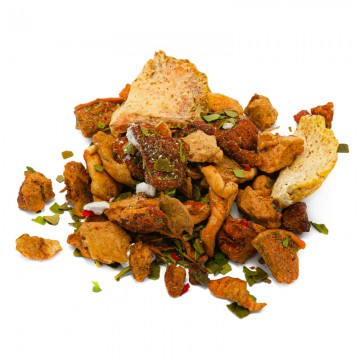
![infuso pesca melone [Natura d'Oriente]](https://www.naturadoriente.com/3535-home_default/infused-peach-melon.jpg)
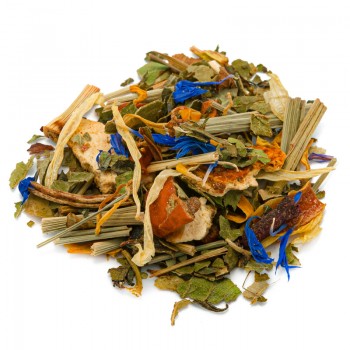
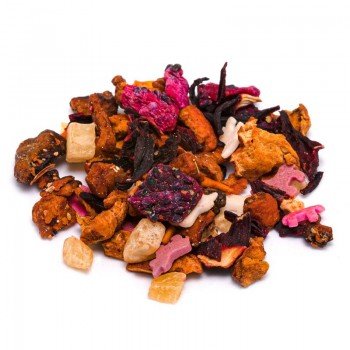
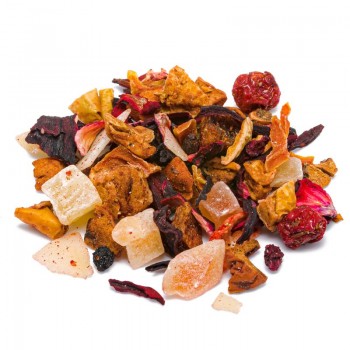
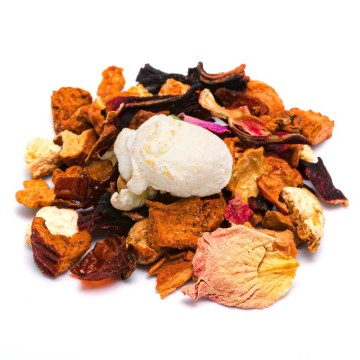
![infuso lime mirtilli rossi [Natura d'Oriente]](https://www.naturadoriente.com/3551-home_default/lime-infused-cranberries.jpg)
